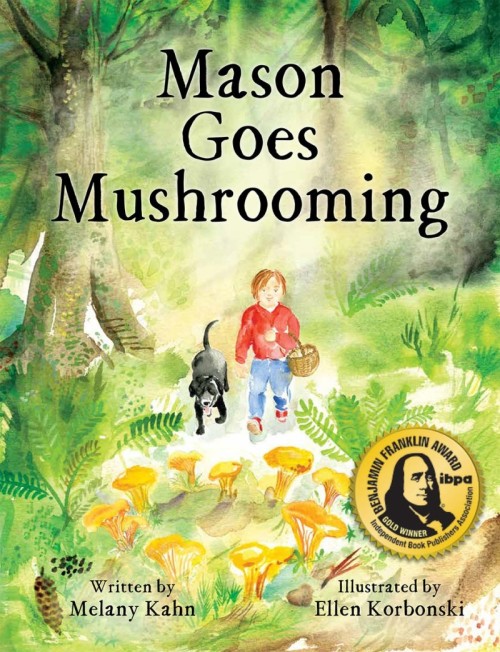by Melany Kahn
Green Writers Press, 2022
In Mason Goes Mushrooming, author Melany Kahn and her young protagonist, Mason, take readers on a series of imaginary foraging adventures, and every walk is a treasure hunt. Each adventure teaches a multilayered lesson, for example, the importance of having the patience to push through failure and the thoughtfulness to learn from nature, whether from the weather, wild animals, or a four-legged best friend.
This is a lovely picture book introduction to mushroom foraging for the entire family. Organized into four chapters, the book showcases mushrooms that fruit at different times, from spring through autumn, while following the story of Mason and his dog, Buddy. Illustrator Ellen Korbonski’s light-filled watercolor illustrations bring the duo’s woodland adventures to life and offer a warm reminder of mushroom season for those reading this book in winter.
Each chapter flows from searching, finding, and cleaning to cooking the mushrooms, with recipes included – a hands-on invitation to new foragers of every age to try mushrooming for themselves. Along the way, Kahn weaves tidbits of foraging advice into the story, from guidance on discovering nature using all the senses to tell-tale identification tips for the four commonly foraged mushrooms profiled in the book. The final page of the book is a summary of identification information for the featured mushrooms.
The book begins as the land wakes in spring. Mason is eager to start his mushrooming season with a morel hunt, during which he learns the value of patience and persistence. This section invites readers to try a wild mushroom omelet, which I can confirm is also delicious with locally cultivated oyster mushrooms (I was reading the book in winter, well before morels can be found).
Mason’s next outing is heralded by the Fourth of July; early summer is chanterelle season. Buddy finds chanterelles growing in a circular fairy ring, a common pattern for many mushrooms. Mason’s dad knows just what to make with these yellow beauties: a creamy pasta dinner. Yet again reading – and cooking – out of season (this time in spring), I tried this recipe with pheasant back (dryad’s saddle) mushrooms. Just as Mason did in the book, my kids gobbled it up.
In the third chapter, it’s late summertime, and lobster mushrooms have come to Mason’s landlocked woods. Lobster mushrooms form when a parasitic ascomycete fungus envelops a gilled mushroom. As with many wild fungi, Mason must clean them thoroughly before sautéeing. With their crunchy red shells and rich umami flavor, just add salt and butter, and these mushrooms areindeed reminiscent of shellfish.
By fall, it’s time to check for black trumpets – not easy when they look just like dead leaves. Mason has a trick up his sleeve: follow the deer that like to snack on them! But don’t forget to share. Unlike the deer, Mason’s family crisps their trumpets into mushroom chips. This was a cooking approach I’d never tried with mushrooms, and once again out of sync with the seasons in the book, I substituted golden oyster mushrooms. My crunchy oyster chips were delicious and disappeared in no time.
As autumn turns to winter, mushroom foraging season ends. Mason spends the cold weather contemplating past and future mushroom adventures and “deep in the earth, the mushrooms rest too, waiting for spring.”


